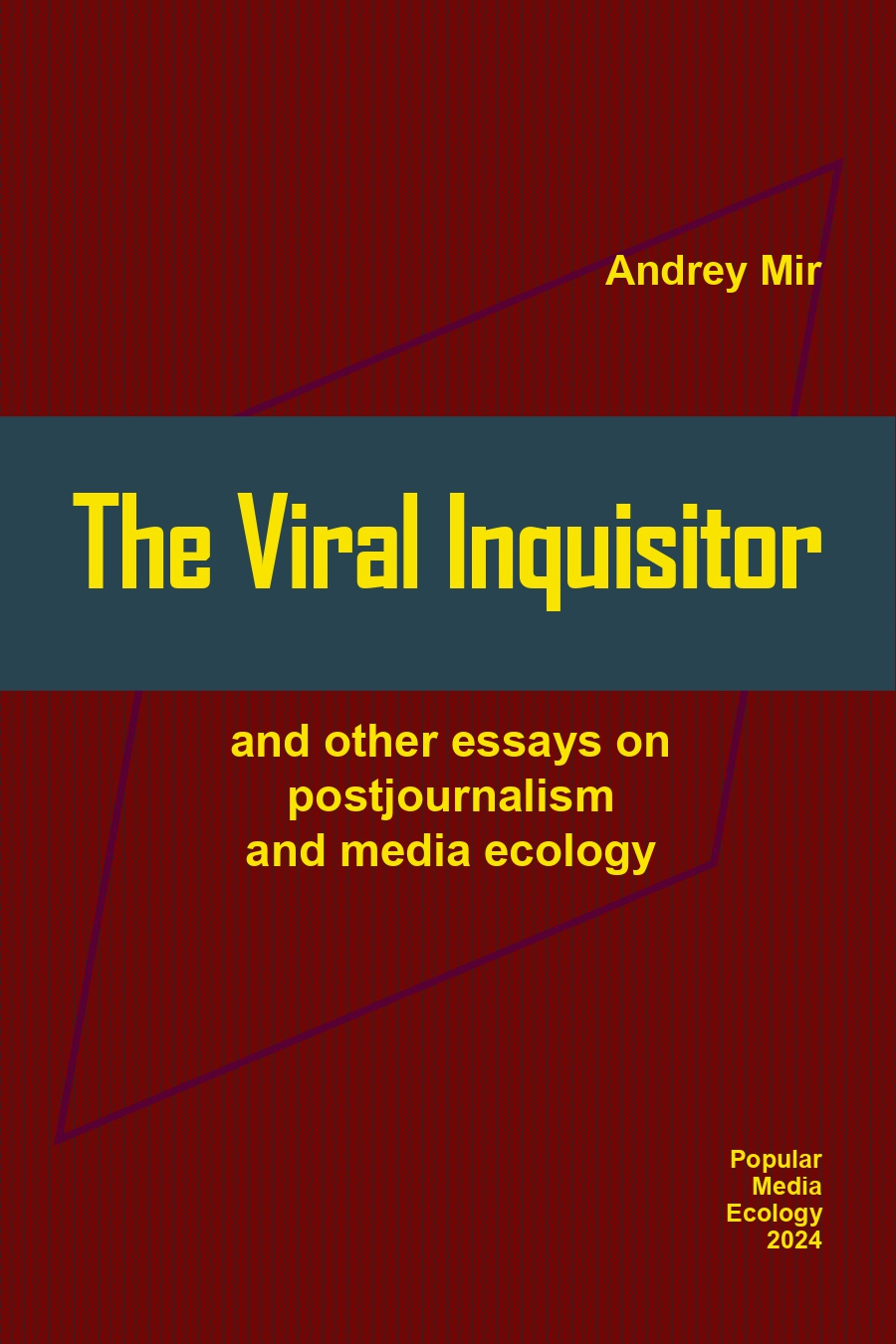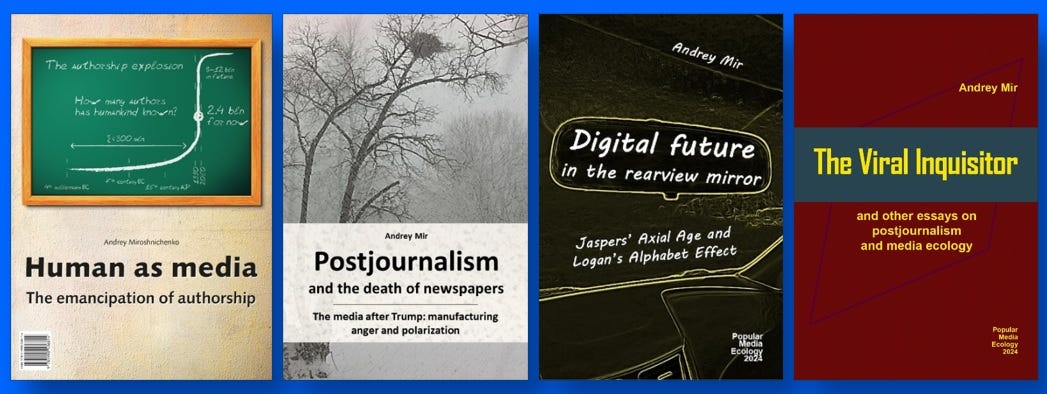The Manifesto of the Viral Editor
From the blogosphere to social media — from the Viral Editor to the Viral Inquisitor
The concept of the Viral Editor was developed in 2009, during the era of the blogosphere and early social media, when users—not algorithms—controlled content distribution. The Viral Editor was a mechanism for collective content selection and distribution, a neural network with users as its processing chips. Users shared links to blog posts they liked; others could see a blog post only if they followed the blog or if friends shared it. Reading a post was always a human decision, made without algorithmic involvement. Comments and reposts rendered certain narratives popular, effectively validating their significance. The Viral Editor not only facilitated the selection, framing, and distribution of content but also served as a nonstop digital referendum deciding what was important.
In the blogosphere, the Viral Editor was entirely human-driven. Social media introduced automation into the Viral Editor, enabling it to extract not only opinions but also attitudes, thus expanding the forms and volume of user engagement. With this transformation, the Viral Editor mutated into the Viral Inquisitor—a metaphor suggested by Martin Gurri in 2022, which I used in the title of my latest book, The Viral Inquisitor and Other Essays on Postjournalism and Media Ecology (2024).
Just a decade after the Viral Editor seized the agenda-setting monopoly from the professional media, it lost it to the algorithms. The shift from the blogosphere to social media transformed the way people exchange information online. Through the same mechanisms that the Viral Editor used to customize content for everyone, the Viral Inquisitor, empowered by algorithms, gathers identity signals of others and delivers them precisely to those most likely to react. If the Viral Editor required participation from everyone in content selection, the Viral Inquisitor demands solidarity with the most widely held views of others.
Yet, understanding the Viral Editor helps to comprehend how its algorithmic mutation, the Viral Inquisitor, works.
Below is the revised version of The Manifesto of the Viral Editor, published in my 2014 book Human as Media: The Emancipation of Authorship.
The Manifesto of the Viral Editor
1. Physiology of the Viral Editor
1.1. The Viral Editor is a dispersed mechanism of content selection and distribution, a neural network whose processing chips are users.
1.2. When users see something noteworthy, they share it in the hope of receiving responses and gaining social capital. They want to affect others.
1.3. The user’s desire to elicit a response fuels the entire system. While weak at the individual, “atomic” level, this motivation generates powerful forces within large arrays of users and drives the Viral Editor’s work.
1.4. Seeking a response, a user selects, refines and shares content according to his or her ideas of what others can react to, which is also the idea of social significance.
1.4.1. This is the same job that a professional editor once did. In the blogosphere, everyone selects, edits, and distributes content they deem interesting. This is what makes it “Editor.”
1.5. While professional editors serve as gatekeepers, determining the importance of various stories before publication, the Internet opens the gates, deciding the significance of content after it’s published, through the process of viral distribution.
1.5.1. If a user succeeds in affecting others, they will pick, edit, and share the content, ushering in the next round of viral distribution. If enough people are affected, it triggers an epidemic of interest in a particular subject. This is what makes it “Viral.”
1.6. The individual acts of micro-editing enable the “interest virus” to mutate until it achieves the optimal form that allows it to infect as many “victims” as possible.
1.7. The Viral Editor delivers not only content selected by users but also its own message. The message of the Viral Editor is the extent and speed of contamination. The range and/or speed of infection indicate the virus’s strength, that is, the importance of the narrative.
1.7.1. Even participants who simply make noise (and they always make up the overwhelming majority) are useful to the Viral Editor, as they sustain the pace and range of thematic infection.
2. The neurophysiology of the Viral Editor
2.1. The Viral Editor, in its functioning, resembles a neural network.
2.2. In response to stimulation, the brain forms differently sized neuron clusters to process thoughts. Similarly, the reflexes of the Viral Editor spontaneously assemble clusters of “neuron-users” around important public issues. Every thematic agitation within a cluster of users represents a “thought” of digital society.
2.3. Unlike the brain, the Viral Editor is capable of capturing its own historical states, expressed through fleeting snapshots of its “neuron-users” reactions. The sequence of these snapshots forms the Viral Editor’s unique archival memory of any past moment, accessible from any future moment.
3. The Viral Editor improves people
3.1 A person’s behavior in the Viral Editor is the direct opposite of their behavior in the crowd.
3.1.1. The crowd triggers the herd instinct in humans, erasing individuality. In contrast, the Viral Editor encourages users to seek responses to their individuality: their assessments, their opinions.
3.2. By choosing, filtering, and sharing content, a person makes efforts aimed at his or her imagined and desirable audience. Participants in the Viral Editor necessarily cultivate their individuality, but within socially approved boundaries, as they seek responses from others to their individual efforts.
3.3. The Viral Editor is a new form of people’s positive socialization.
3.4. Occasionally, users may elicit a response through perverse behavior. However, in general, most people strive to conform to the criteria approved by the majority.
3.5. This doesn’t mean that everyone in the Viral Editor is good. It simply means that the average person strives to appear better by exposing themselves individually to judgment by others in pursuit of acceptance and affirmation.
3.6. Anyway, the original quality of human material influences the final quality of viral editing.
4. The Viral Editor improves itself
4.1. In order to participate in viral editing, users must be capable of performing a wide range of complex intellectual tasks. They should be able to: a) read, b) understand, c) evaluate, d) write, e) invest some of their own passion (if nothing else, through the very act of reposting).
4.1.1. Thus, even at the entry point to the system, the Viral Editor “checks” the participant’s personal qualities. A person whose reactions are irrelevant will not generate much of a response and, as a result, will not contribute to content distribution.
4.2. Having joined viral editing, users activate their socialization mode and judge based on socially approved criteria, thus not only improving their public appearance but also enhancing the overall quality of viral editing.
4.3. The Viral Editor represents pure freedom of personal reaction. Orchestrated reactions can be injected, but, on a statistical scale, they are revealed and neutralized by the overwhelming number of free reactions.
4.3.1. Trojan messages in the Viral Editor fade away on their own or are loudly debunked. The Viral Editor has a built-in self-cleaning mechanism.
4.3.2. If a lie is significant, it will circulate until it reaches witnesses and experts who will denounce it because they know the truth. If a lie is insignificant, no one will denounce it, but that’s because it won’t circulate.
4.3.3. Any example of a lie on the internet is actually an example of debunking it.
4.4. The more Trojan messages of a marketing or political nature there are, the stronger the Viral Editor’s immunity to them becomes.
4.5. Regardless of the nonsense and filth posted online, people generally want to present their better selves. The collective work of self-expression through content selection, editing, and sharing improves the moral and intellectual quality of both users and content.
4.5.1. This distinguishes the Viral Editor from the crowd, which degenerates individuals, and from rumors, which degenerate content.
5. The Viral Editor is destroying journalism
5.1. Through the collective work of selection and distribution, the Viral Editor turns the noteworthy for one into the newsworthy for many, thus killing traditional journalism.
5.2. The Viral Editor can marshal evidence from anywhere. News organizations must dispatch reporters to cover faraway events, but people with cell phones will already be there, on the ground. The Viral Editor has its own correspondents wherever something might happen.
5.2.1. This deprives old media of the monopoly over reporting breaking news.
5.3. The Viral Editor possesses more expertise than any single newsroom ever could. It recruits all the experts and witnesses that society has, and they all compete for recognition by sharing their knowledge.
5.3.1. This deprives old media of the monopoly over analysis, expertise, and commentary.
5.4. The Viral Editor can deliver the news precisely to those it may concern. Our news feed is made by our friends – people with similar tastes, interests, views, and social standing. They – we – select, comment, and deliver information to one another with the highest possible relevance, not just for “people like us” but precisely for us.
5.4.1. This gives the content delivered to each user by the Viral Editor a level of relevance and personal customization unimaginable in old media.
5.5. The Viral Editor captures the entire content of the Internet but only selects what is of interest to active users, delivering it to those for whom it may be relevant. This is how the Viral Editor converts a vast pile of rubbish into a valuable product.
5.6. What may be a hard investigation in journalism is routine entertainment for the Viral Editor.
6. The Viral Editor supplies all the news for free
6.1. The Viral Editor works because users are interested in everything that might interest people. Due to their vast number, users explore many topics, including—accidentally but inevitably—the significant ones.
6.1.1. The Viral Editor is capable of discovering everything.
6.1.2. The hidden information is hidden precisely because of its potential impact, which creates additional value for those who can share it. Due to the Viral Editor’s omnipresence and hunger to share, any restriction of access eventually leads to leaks.
6.2. Since users are connected with those who have similar interests, and the shared news is refined and delivered precisely to those for whom it is relevant, a user can’t help but learn news that aligns with their interests.
6.2.1. People no longer hunt for news; news hunts for people.
6.3. What journalists do on purpose and for money, the Viral Editor does by chance, but inevitably and for free.
6.4. In the new media environment, content will be paid for not by those who want to receive it, but by those who want to distribute it.
7. The Viral Editor has no will
7.1. The Viral Editor is nothing more than a side effect of the viral distribution of messages through a network of filters that modify them for better distribution. The Viral Editor has no goals of its own.
7.2. Whether or not users recognize their pursuit of affirmation, they mostly share content willingly. Their individual wills, however, do not result in a unified will of the Viral Editor.
7.3. The Viral Editor does not seek approval. Nothing is prohibited for the Viral Editor. It has no center or headquarters.
7.4. The Viral Editor has no location. It does not belong to anyone.
8. The Viral Editor sees no future
8.1. Due to having neither will nor centre, the Viral Editor has no identity.
8.1.2. Therefore, the Viral Editor’s reactions are vegetative; it only reacts to what happens.
8.2. The Viral Editor is reactive, while the human editor is proactive.
8.3. If an event has not yet happened, the Viral Editor has nothing to react to. The future does not exist for the Viral Editor.
9. The Viral Editor has taken everything away from the mass media except for navigation of the future and the panoramic agenda
9.1. The Viral Editor has destroyed the mass media’s monopoly over news, analytics, opinions, and content distribution.
9.1.1. The Viral Editor has stripped the mass media of their monopoly on producing guidance and benchmarks, mastering the ability to rival or even exceed professional media in refining social significance.
9.2. The Viral Editor sees what is essential, interesting, and significant; it can focus but does not see a panorama. To see the full picture of the world in the blogosphere, it is necessary to read the entire blogosphere. In the mass media, it is sufficient to leaf through a magazine or newspaper, or just have a look at the news.
9.3. The mass media condense the big picture of the world into a compact and comprehensible agenda using a simple template: Politics/Economics/Culture/Society/Sports, or something similar. The media editor fills in each section, even if the events are not top-rated. By distilling the world into an agenda, the media foster social cohesion.
9.4. The mass media are limited by the production process and must complete a news story by the time of printing or airing. The Viral Editor follows the flow and does not face deadlines for completing stories. The completeness of a news story remains the prerogative of professional journalism.
9.5. The completeness of the story, the panoramic agenda, and the navigation of the future remain the last three functions of journalism that the Viral Editor cannot hijack.
10. The Viral Editor is a new form of social contract
10.1. The Viral Editor not only provides the selection, framing, and distribution of content but also serves as a nonstop referendum on matters of public significance.
10.1.1. By filtering and distributing content, people not only “cast their votes” for its significance but also “improve the ballot” directly during the voting process.
10.2. Reposts are the simplest and most accessible form of civic engagement.
10.3. The dominant opinions and attitudes developed by the Viral Editor can’t be mandatory for implementation, but they generate social gravitation that can influence reality.
10.4. The Viral Editor does not focus on politics. It engages with everything, including utter nonsense. However, public and social concerns elicit a better response and, therefore, gain more attention from the Viral Editor.
10.5. The Viral Editor is a mechanism of a virtual social contract—a self-constructed, eclectic, and fluid consensus of users regarding key public concerns.
10.6. The turnout in the Viral Editor is accidental but 100% representative. Thematic epidemics within the Viral Editor serve as instant forms of direct democracy and disrupt the narratives maintained by the institutions of representative democracy.
10.7. When authorities suppress certain facts or opinions, these facts or opinions burst into the realm of free expression with increasing intensity, providing a greater potential for response. This is why the Viral Editor tends to radicalize people and opinions that are underrepresented in the mainstream.
10.7.1. Due to these conditions, the Viral Editor inevitably stands in opposition to the authorities.
10.8. The long-term coexistence of the Viral Editor and power based on narrative suppression is untenable. The Viral Editor’s free sublimation of significance inevitably diverts people from institutions that misrepresent them.
10.8.1. As more users join, the Viral Editor will eventually undermine the authorities that sustain their control through streamlining narratives and representations.
10.8.2. This does not mean that the Viral Editor is capable of building something to replace what it disrupts. The Viral Editor does not and cannot have political programs.
See also books by Andrey Mir:
The Viral Inquisitor and other essays on postjournalism and media ecology (2024)
Digital Future in the Rearview Mirror: Jaspers’ Axial Age and Logan’s Alphabet Effect (2024)







